



Pig growth is impaired by soybean meal displacement in the diet
Discover the real value of balancing feed cost with outputEditor’s note: Eric van Heugten, PhD, professor and swine extension specialist at North Carolina State University, recently spoke at the Iowa Swine Day Pre-Conference Symposium, titled Soybean Meal 360°: Expanding our horizons through discoveries and field-proven feeding strategies for improving pork production. The event was sponsored by Iowa State University and U.S. Soy.
Soybean meal offers pig producers a high-value proposition. It’s a high-quality protein source, providing essential and non-essential amino acids to the pig that are highly digestible and palatable. Studies now show that soybean meal provides higher net energy than current National Research Council (NRC) requirements. Plus, soybean meal offers health benefits such as isoflavones and antioxidants as well as benefits with respiratory diseases such as porcine reproductive and respiratory syndrome (PRRS).
One of several ingredients that compete with the inclusion of soybean meal in pig diets is dried distillers grains with solubles (DDGS).
“With DDGS, we typically see more variable responses because of the quality differences depending on which plant it comes from,” said Dr. van Heugten. “At very high levels, we often see a reduction in performance especially with feed intake which can have negative consequences on pig performance, especially in the summer months when feed intake is already low and gaining weight is at a premium to get them to market.”
Over the last few decades, the industry has also seen the increased inclusion of crystalline amino acids in pig diets.
“We started with lysine at about 3 lbs. per ton in the diet, and then we added methionine and threonine to go to 6 to 8 lbs. per ton,” he said. “Now we have tryptophan, isoleucine and valine and can go to 12 to 15 lbs. per ton. All of these, when price competitive, are formulated into the diet and are displacing soybean meal which also removes the potential health benefits that soybean meal provides.”
Soybean meal displacement research in growing pigs and finishers
Dr. van Heugten led new research to evaluate the impact of soybean meal displacement by DDGS and crystalline amino acids on growth performance and carcass quality of growing and finishing pigs.
“We hypothesized that if we take soybean meal out of the diet, it will impair growth performance even in healthy pigs,” he said. “And the last objective was to construct response growth curves to dietary soybean meal inclusion based on growth performance.”
Two studies were conducted – one with growing pigs and one with finisher pigs. The growing pig study used 512 pigs in university facilities with 64 pens with four barrows and four gilts per pen. Starting body weight was 85 lbs., and final body weight was 161 lbs.
Pigs were fed in two dietary phases: phase 1 diet for 21 days and phase 2 diet for 18 days. The design was a 2x4 factorial. The table below shows blue as the control with 0% DDGS inclusion and orange as the DDGS-containing diet.

“The diets were formulated by a commercial company, and we did that on purpose because we wanted to make sure the ingredient values we used were industry representative,” he said.
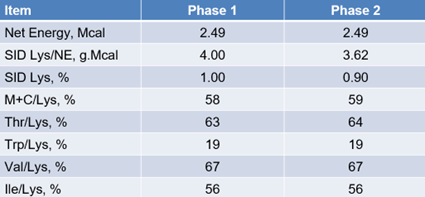
“We formulated based on an ideal protein level, but they're all a little bit higher than what NRC recommends,” he noted.
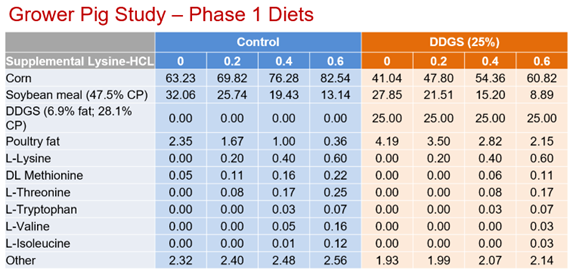
When increasing the amount of crystalline lysine in the diet, it reduces the soybean meal level. Poultry fat was used to correct the net energy value. As soybean meal was reduced, the amount of poultry fat was reduced with increasing amounts of crystalline amino acids.
The net energy value used was relatively close to the NRC recommendation. When increasing the supplemental lysine content, the amount of crystalline amino acids must also increase.
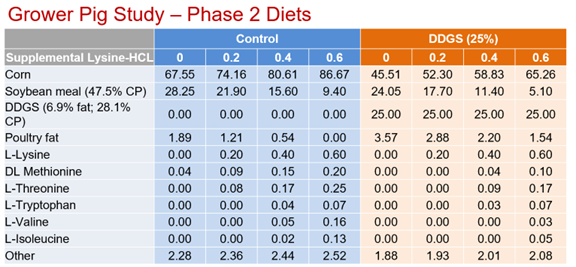
“The performance data (below) shows finishing body weight at the end of this trial (left) and there is an interactive effect,” said Dr. van Heugten. “There’s a linear reduction in the control diet, while there’s a quadratic response in the DDGS diet. But with the DDGS effect, you can see a significant reduction in body weight by 2.47 lbs. Then, with lysine and amino acids included at 0.6%, or 12 lbs. per ton, it decreased body weight at marketing by 5.71 lbs. The average daily gain (ADG) chart (right) reflects the same pattern as body weight as you might expect.”
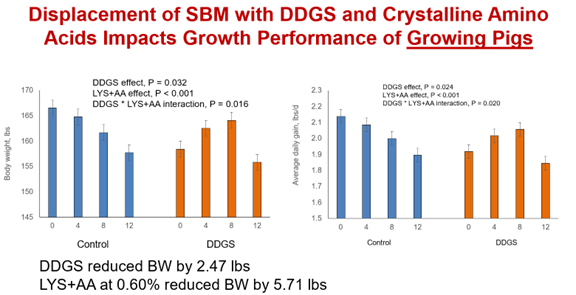
The feed:gain impact indicated a linear effect of lysine, where the inclusion of lysine worsened feed:gain. Thus, it will take more feed per pound of gain.
“The DDGS effect worsened feed efficiency by 3.2% (0.08 points), and lysine increased feed:gain by 4.2% (0.1 points). Using regression analysis, we plotted the amount of soybean meal included in the diet against total gain and feed:gain,” he said.
As soybean meal inclusion in the diet increased, there was an increase in total gain. In growing pigs, displacement of soybean meal from 31% to 6% compromised gain by 7.7 lbs. and the feed:gain ratio by 0.17 units.
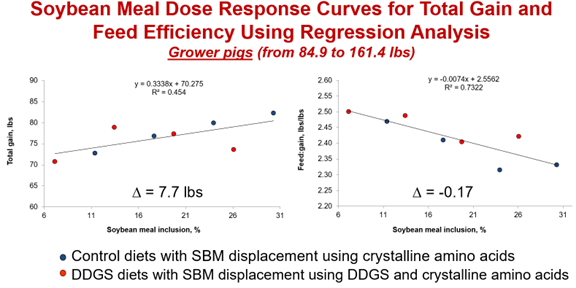
An economic evaluation showed that increasing the amount of crystalline lysine in the diet was less expensive, indicating that lysine was cost competitive. The diets with the DDGS were also beneficial for the cost of the diet.
“The feed-cost-per-pig decreased as the amount of lysine in the diet increased. But when you calculate the net value, accounting for the feed cost and also accounting for how many extra pounds of pig you produce, the net value is actually the best at 4 lbs. per ton inclusion in the control diet, and it's best with 8 lbs. per ton inclusion in the DDGS diet,” he explained.
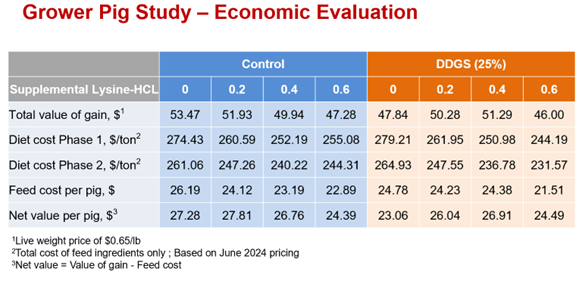
Finisher pig study results
The finisher pig study was set up similarly, using 480 pigs in 80 pens with three barrows and three gilts per pen. The pigs had a starting body weight of 183 lbs., and closed out at a final body weight of 275 lbs. There were two dietary phases: phase one was 21 days, and in phase two, half the pigs were sold after 13 days and the rest were sold one week later (20 days).

Diets were formulated by a commercial feed company based on net energy and SID amino acids and ideal protein concepts using relevant nutrient matrix values and feed ingredient costs.
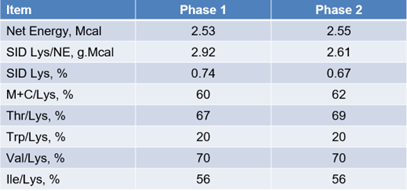
“The SID lysine level for phase one was 0.74 and for phase two it was 0.67. The ratios of amino acids to lysine are a little bit higher than what NRC suggests,” he said. “Soybean meal inclusion goes to very low levels in these finishing diets when we are including 12 lbs. per ton of lysine, so in the control diet we're going to 2.85% soybean meal inclusion. In the DDGS diet, we didn't need any soybean meal at all, so we took it all out.”
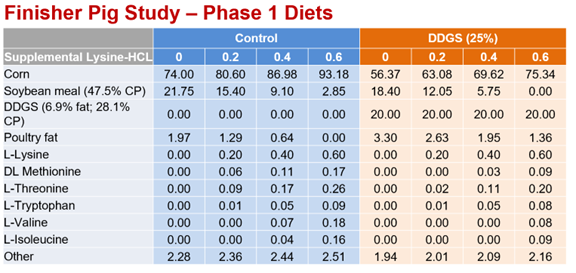
“In the second phase diet, it’s similar – the soybean meal level was reduced in those diets as well. In fact, in the last diet, we didn't even need the amount of crystalline lysine that we were targeting,” he explained. “By adding 12 lbs. per ton of crystalline lysine, we were at levels over the requirement for lysine.”
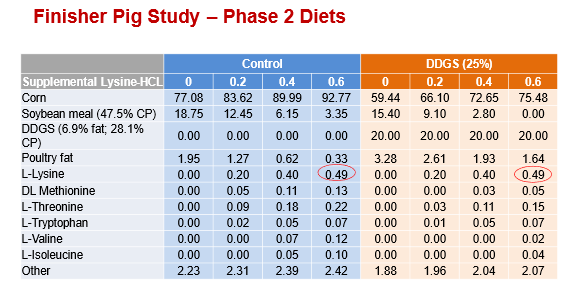
Looking at growth performance of the finishing pigs, there wasn’t an interaction, but there was a DDGS effect. Use of DDGS decreased body weight by 2.69 lbs.
“We also saw a linear effect of lysine inclusion. When comparing the lowest level of lysine with the highest lysine inclusion, the difference was 6.04 lbs. of body weight,” he said. “Average daily gain reflects the same thing because the body weight that we started with was the same between the treatments, so you would expect average daily gain to have a similar pattern.”
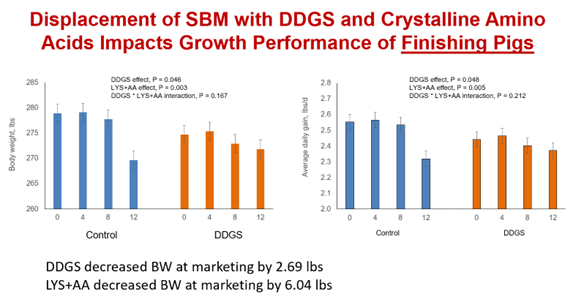
The impact on feed intake (left) showed a quadratic response in the control diet and a cubic response in the DDGS diet. As noted earlier, there is a tendency for DDGS to reduce feed intake. The feed:gain impact showed no interaction for DDGS, but the lysine plus amino acid effect worsened feed:gain by 5% (0.16 points).
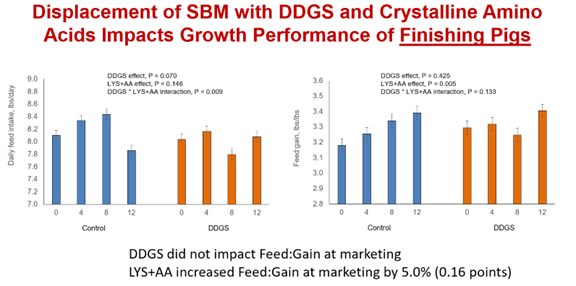
The DDGS diet does show a significant decrease in yield. In addition to a reduction in body weight and yield, there’s an extra reduction in actual carcass weight at the end of the study.
“When we plot the soybean meal inclusion (x-axis) against total gain (y-axis), you see a linear increase in total gain as you increase soybean meal inclusion in the diet,” he said. “Looking at the extremes, that difference is 10.4 lbs. of extra body weight by including more soybean meal in the diet. The right chart shows feed efficiency, and as you increase soybean meal inclusion, less feed is required per unit of gain. That difference was 0.18 points.”
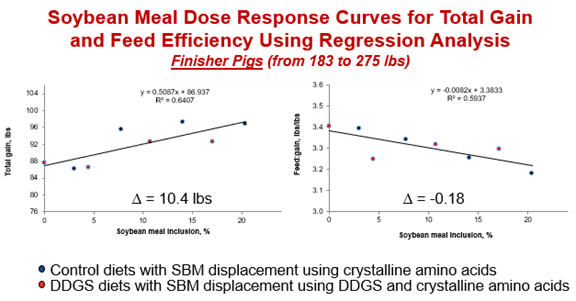
“An economic evaluation showed that feed cost per pig becomes cheaper as you increase lysine in the diet,” he said. “But ultimately, the net value, accounting for the benefit from body weight gain and feed efficiency, shows the best response is 4 lbs. per ton for the control diet, similar to what we saw in the grower pig study. Then it’s 4 lbs. per ton for DDGS, and 8 lbs. per ton for the grower diet.”
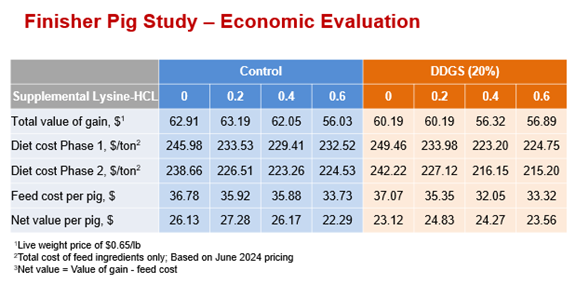
Proposed optimal soybean meal inclusion
Dr. van Heugten calculated a proposed optimal soybean meal inclusion level to achieve the maximum growth for each feeding phase for pigs under high health conditions.
The graph below shows the best response for every phase.
“We created a curve to suggest some minimum specifications of soybean meal that could potentially offer a growth response and give you return on investment,” he said. “At about 100 lbs. of pig body weight, the ideal level of soybean meal in that diet was 640 lbs. For the heaviest pigs at 255 lbs., the inclusion of 280 lbs. per ton of soybean meal gave us the best response. In these curves, we based the best response on gain and feed efficiency, counting gain as 80% of the equation and feed efficiency as 20% of the equation.”

Conclusions
Diets were very carefully formulated based on net energy and SID amino acid specifications for each growth phase. The displacement of soybean meal from 31% to 6% in growing pig diets compromised gain by over 7 lbs. and a feed:gain ratio of 0.17 units. This means that by increasing the soybean meal in the diet, it increased gain by 7 lbs. and improved feed efficiency. In finishing pig diets, when soybean meal increased to 21%, there was a benefit of 10 lbs. and the feed:gain ratio improved by 1.8 units.
“Based on our findings, we propose a minimum soybean meal specification throughout the growth cycle for the finishing pigs to maximize profitability. The soybean meal curve provides a starting point for fine-tuning and application in commercial production. This is especially important in the summer when time is fixed and you have to get these pigs to market,” said van Heugten. “They're not going to grow as well in the summer, so time is of the essence. If we can get any extra performance in the summer, it becomes much more valuable.”
Dr. van Heugten also proposed that biologically functional components in soybean meal play a role in the improvements of growth performance even in healthy pig populations.
“The take-home message is that it's very tempting to focus on feed cost, especially considering that feed cost conservatively represents about 60% to 70% of the total production cost,” he concluded. “In our studies, when we include higher levels of soybean meal, we increased the price of the diet, but when you look at the benefits that we gained – the weight gain and the feed efficiency of the pig – that’s a lot of money to give up just to save on the cost of feed. So, it's important to balance feed cost with output in terms of how many pounds of pigs are actually getting out the door to market.”
Click here to learn more.
Brought to you by U.S. Soy. Fully funded by the National Soybean Checkoff.









